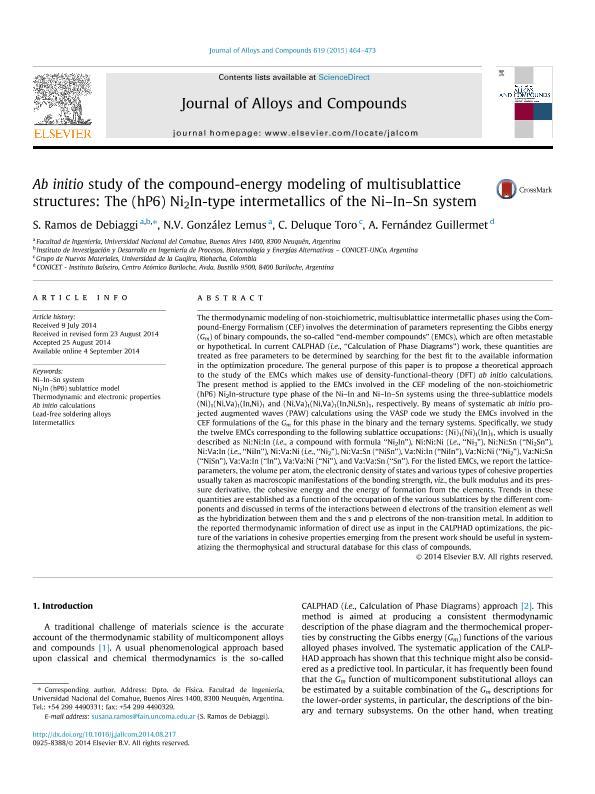Artículo
Ab initio study of the compound-energy modeling of multisublattice structures: the (hP6) Ni2In-type intermetallics of the Ni–In–Sn system
Ramos, Susana Beatriz ; Gonzalez Lemus, Nasly Vanessa
; Gonzalez Lemus, Nasly Vanessa ; Deluque Toro, C.; Fernandez Guillermet, Armando Jorge
; Deluque Toro, C.; Fernandez Guillermet, Armando Jorge
 ; Gonzalez Lemus, Nasly Vanessa
; Gonzalez Lemus, Nasly Vanessa ; Deluque Toro, C.; Fernandez Guillermet, Armando Jorge
; Deluque Toro, C.; Fernandez Guillermet, Armando Jorge
Fecha de publicación:
01/2014
Editorial:
Elsevier Science
Revista:
Journal Of Alloys And Compounds
ISSN:
0925-8388
Idioma:
Inglés
Tipo de recurso:
Artículo publicado
Clasificación temática:
Resumen
The thermodynamic modeling of non-stoichiometric, multisublattice intermetallic phases using the Compound-Energy Formalism (CEF) involves the determination of parameters representing the Gibbs energy (Gm) of binary compounds, the so-called ‘‘end-member compounds’’ (EMCs), which are often metastable or hypothetical. In current CALPHAD (i.e., ‘‘Calculation of Phase Diagrams’’) work, these quantities are treated as free parameters to be determined by searching for the best fit to the available information in the optimization procedure. The general purpose of this paper is to propose a theoretical approach to the study of the EMCs which makes use of density-functional-theory (DFT) ab initio calculations. The present method is applied to the EMCs involved in the CEF modeling of the non-stoichiometric (hP6) Ni2In-structure type phase of the Ni–In and Ni–In–Sn systems using the three-sublattice models (Ni)1(Ni,Va)1(In,Ni)1 and (Ni,Va)1(Ni,Va)1(In,Ni,Sn)1, respectively. By means of systematic ab initio projected augmented waves (PAW) calculations using the VASP code we study the EMCs involved in the CEF formulations of the Gm for this phase in the binary and the ternary systems. Specifically, we study the twelve EMCs corresponding to the following sublattice occupations: (Ni)1(Ni)1(In)1, which is usually described as Ni:Ni:In (i.e., a compound with formula ‘‘Ni2In’’), Ni:Ni:Ni (i.e., ‘‘Ni3’’), Ni:Ni:Sn (‘‘Ni2Sn’’), Ni:Va:In (i.e., ‘‘NiIn’’), Ni:Va:Ni (i.e., ‘‘Ni2’’), Ni:Va:Sn (‘‘NiSn’’), Va:Ni:In (‘‘NiIn’’), Va:Ni:Ni (‘‘Ni2’’), Va:Ni:Sn (‘‘NiSn’’), Va:Va:In (‘‘In’’), Va:Va:Ni (‘‘Ni’’), and Va:Va:Sn (‘‘Sn’’). For the listed EMCs, we report the latticeparameters, the volume per atom, the electronic density of states and various types of cohesive properties usually taken as macroscopic manifestations of the bonding strength, viz., the bulk modulus and its pressure derivative, the cohesive energy and the energy of formation from the elements. Trends in these quantities are established as a function of the occupation of the various sublattices by the different components and discussed in terms of the interactions between d electrons of the transition element as well as the hybridization between them and the s and p electrons of the non-transition metal. In addition to the reported thermodynamic information of direct use as input in the CALPHAD optimizations, the picture of the variations in cohesive properties emerging from the present work should be useful in systematizing the thermophysical and structural database for this class of compounds.
Archivos asociados
Licencia
Identificadores
Colecciones
Articulos(CCT - PATAGONIA NORTE)
Articulos de CTRO.CIENTIFICO TECNOL.CONICET - PATAGONIA NORTE
Articulos de CTRO.CIENTIFICO TECNOL.CONICET - PATAGONIA NORTE
Articulos(PROBIEN)
Articulos de INST. DE INVESTIGACION Y DES. EN ING. DE PROCESOS, BIOTECNOLOGIA Y ENERGIAS ALTERNATIVAS
Articulos de INST. DE INVESTIGACION Y DES. EN ING. DE PROCESOS, BIOTECNOLOGIA Y ENERGIAS ALTERNATIVAS
Citación
Ramos, Susana Beatriz; Gonzalez Lemus, Nasly Vanessa; Deluque Toro, C.; Fernandez Guillermet, Armando Jorge; Ab initio study of the compound-energy modeling of multisublattice structures: the (hP6) Ni2In-type intermetallics of the Ni–In–Sn system; Elsevier Science; Journal Of Alloys And Compounds; 619; 1-2014; 464-473
Compartir



